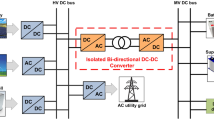Abstract
Twice ripple power exists in single-phase to three-phase reduced-switch induction motor drives, which degrades the performance of the drive system, such as larger total harmonic distortion of the grid current, the larger ripple voltage in the dc link and the larger torque ripple. Most existing power decoupling schemes are open-loop decoupling methods. However, the open-loop decoupling method has the disadvantages of heavy computation and strong dependency of parameters. This paper analyzes all steady state solutions of the decoupling capacitor voltage from the point of view of solving differential equations and presents a unified multi-proportional-resonant closed-loop decoupling method to suppress the ripple voltage on the dc bus. The whole drive system adopts a hybrid predictive control strategy with dual loops to coordinate the operation of each part. Comprehensive experimental results are presented to verify the effectiveness of the presented method.












Similar content being viewed by others
References
Domijian A, Hanhock O, Maytrott C (1992) A study and evaluation of power electronic based adjustable speed motor drives for air conditioners and heat pumps whit an example utility case study of the Florida and light company. IEEE Trans Energy Convers 7(3):396–404. https://doi.org/10.1109/60.148558
Noroes Maia AC, Jacobina CB (2017) Single-phase ac–dc–ac topology for grid overvoltage and voltage harmonic mitigation. IET Power Electron 10(12):1626–1637. https://doi.org/10.1049/iet-pel.2016.0934
Lee BK, Fahimi B, Ehsani M (2001) Overview of reduced parts converter topologies for ac motor drives. In: Proceedings on international conference power electronics specialists, Vancouver, Canada, pp 2019–2024. https://doi.org/10.1109/PESC.2001.954418
Heydari M, Fahimi A, Varjani AY (2017) A reduced switch count three-phase AC–AC converter with six power switches: modeling, analysis, and control. IEEE J Emerg Sel Topics Power Electron 5(4):1720–1738. https://doi.org/10.1109/JESTPE.2017.2720722
Shi SQ, Sun Y, Su M (2018) Hybrid predictive control strategy for a low-cost converter-fed IM drive. IET Electr Power Appl 12(4):581–587. https://doi.org/10.1049/iet-epa.2017.0587
Liu WC, Wang KW, Chung HS, Chuang ST (2015) Modeling and design of series voltage compensator for reduction of DC-link capacitance in grid-tie solar inverter. IEEE Trans Power Electron 30(5):2534–2548. https://doi.org/10.1109/TPEL.2014.2336856
Wang H, Blaabjerg F (2014) Reliability of capacitors for DC-link applications in power electronic converters—an overview. IEEE Trans Ind Appl 50(5):3569–3578. https://doi.org/10.1109/TIA.2014.2308357
Zhu G, Wang H, Liang B, Tan S, Jiang J (2016) Enhanced single-phase full-bridge inverter with minimal low-frequency current ripple. IEEE Trans Ind Electron 63(2):937–943. https://doi.org/10.1109/TIE.2015.2491881
Mellincovsky M, Yuhimenko VM, Peretz M, Kuperman A (2017) Low-frequency DC-link ripple elimination in power converters with reduced capacitance by multiresonant direct voltage regulation. IEEE Trans Ind Electron 64(3):2015–2023. https://doi.org/10.1109/TIE.2016.2626241
Abeywardana DBW, Hredzak B, Agelidis VG (2016) A rule-based controller to mitigate DC-side second-order harmonic current in a single-phase boost inverter. IEEE Trans Power Electron 31(2):1665–1679. https://doi.org/10.1109/TPEL.2015.2421494
Sun Y, Liu YL, Su M, Xiong WJ et al (2016) Review of active power decoupling topologies in single-phase systems. IEEE Trans Power Electron 31(7):4778–4794. https://doi.org/10.1109/TPEL.2015.2477882
Tang Y, Blaabjerg F, Loh PC, Jin C, Wang P (2015) Decoupling of fluctuating power in single-phase systems through a symmetrical half-bridge circuit. IEEE Trans Power Electron 30(4):1855–1865. https://doi.org/10.1109/TPEL.2014.2327134
Li H, Zhang K, Zhao H, Fan S, Xiong J (2013) Active power decoupling for high-power single-phase PWM rectifiers. IEEE Trans Power Electron 28(3):1308–1319. https://doi.org/10.1109/TPEL.2012.2208764
Serban I (2015) Power decoupling method for single-phase H-bridge inverters with no additional power electronics. IEEE Trans Ind Electron 62(8):4805–4813. https://doi.org/10.1109/TIE.2015.2399274
Tang Y, Qin Z, Blaabjerg F, Loh PC (2015) A dual voltage control strategy for single-phase PWM converters with power decoupling Function. IEEE Trans Power Electron 30(12):7060–7071. https://doi.org/10.1109/TPEL.2014.2385032
Li S, Qi W, Tan SC, Hui SY (2016) Integration of an active filter and a single-phase AC/DC converter with reduced capacitance requirement and component count. IEEE Trans Power Electron 31(6):4121–4137. https://doi.org/10.1109/TPEL.2015.2476361
Tang Y, Zhu D, Jin C, Wang P, Blaabjerg F (2015) A three-level quasi two-stage single-phase PFC converter with flexible output voltage and improved conversion efficiency. IEEE Trans Power Electron 30(2):717–726. https://doi.org/10.1109/TPEL.2014.2314136
Huang KP, Wang Y, Wai RJ (2019) Design of power decoupling strategy for single-phase grid-connected inverter under nonideal power grid. IEEE Trans Power Electron 34(3):2938–2955. https://doi.org/10.1109/TPEL.2018.2845466
Cortes P, Kazmierkowski MP, Kennel RM, Quevedo DE, Rodriguez J (2008) Predictive control in power electronics and drives. IEEE Trans Ind Electron 55(12):4312–4324. https://doi.org/10.1109/TIE.2008.2007480
Formentini A, Trentin A, Marchesoni M et al (2015) Speed finite control set model predictive control of a PMSM fed by matrix converter. IEEE Trans Ind Electron 62(11):6786–6796. https://doi.org/10.1109/TIE.2015.2442526
Vazquez S, Rodriguez J, Rivera M et al (2017) Model predictive control for power converters and drives: advances and trends. IEEE Trans Ind Electron 64(2):935–947. https://doi.org/10.1109/TIE.2016.2625238
Acknowledgements
This work was supported in part by the National Key R&D Program of China under Grant 2018YFB0606005, in part by the National Natural Science Foundation of China under Grant No. 61933011, in part by the Major Project of Changzhutan Self-dependent Innovation Demonstration Area under Grant 2018XK2002, in part by the Project of Innovation-driven Plan in Central South University under Grant 2019CX003, in part by the Scientific Research Project of Hunan Department of Education under Grant No. 18C0787, in part by the CRRC Zhuzhou Electric Locomotive Institute Co., Ltd.
Author information
Authors and Affiliations
Corresponding author
Additional information
Publisher's Note
Springer Nature remains neutral with regard to jurisdictional claims in published maps and institutional affiliations.
Rights and permissions
About this article
Cite this article
Shi, S., Sun, Y., Dan, H. et al. A general closed-loop power-decoupling control for reduced-switch converter-fed IM drives. Electr Eng 102, 2423–2433 (2020). https://doi.org/10.1007/s00202-020-01023-5
Received:
Accepted:
Published:
Issue Date:
DOI: https://doi.org/10.1007/s00202-020-01023-5




